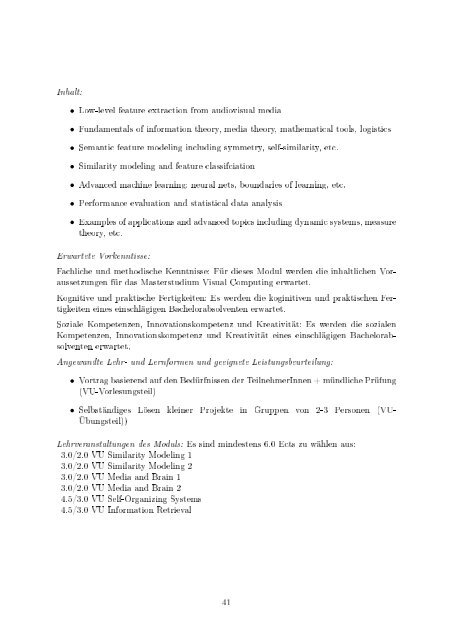Masterstudium Visual Computing - Fakultät für Informatik, TU Wien
Masterstudium Visual Computing - Fakultät für Informatik, TU Wien Masterstudium Visual Computing - Fakultät für Informatik, TU Wien
• The students are aware of the theories behind digital media, human perception, semantics and concepts. • The students are able to identify the fundamental building blocks of feature transforms. • The students are able to extract simple color, texture, shape, audio and video features from audiovisual content. • The students are able to extract complex local features, spectral audio features and time-based video features from audiovisual content. • The students are able to extract semantic features from media content. • The students are able to apply statistical ltering methods on the extracted features. • The students are aware of dynamic ltering methods. • The students are able to select and apply a simple classication method on the extracted features. • The students understand the four psychological theories of human similarity perception and are able to apply them. • The students understand complex machine learning techniques such as Support Vector Machines and Mixture Models. • The students understand brain-like articial neural networks such as Spiking nets, Hopeld nets and Boltzmann machines. Kognitive und praktische Fertigkeiten: • The students are aware of the psychological theory of human similarity perception. • The students are able to implement media understanding applications in JavaME on mobile devices. • The students are able to implement sophisticated media understanding applications in Matlab. Soziale Kompetenzen, Innovationskompetenz und Kreativität: • The students gain experience in scientic team work • The students are able to discuss the lecture contents in scientic discourses. • The students are able to discuss semantic features extraction and classication in scientic discourses. 40
Inhalt: • Low-level feature extraction from audiovisual media • Fundamentals of information theory, media theory, mathematical tools, logistics • Semantic feature modeling including symmetry, self-similarity, etc. • Similarity modeling and feature classifciation • Advanced machine learning: neural nets, boundaries of learning, etc. • Performance evaluation and statistical data analysis • Examples of applications and advanced topics including dynamic systems, measure theory, etc. Erwartete Vorkenntisse: Fachliche und methodische Kenntnisse: Für dieses Modul werden die inhaltlichen Voraussetzungen für das Masterstudium Visual Computing erwartet. Kognitive und praktische Fertigkeiten: Es werden die koginitiven und praktischen Fertigkeiten eines einschlägigen Bachelorabsolventen erwartet. Soziale Kompetenzen, Innovationskompetenz und Kreativität: Es werden die sozialen Kompetenzen, Innovationskompetenz und Kreativität eines einschlägigen Bachelorabsolventen erwartet. Angewandte Lehr- und Lernformen und geeignete Leistungsbeurteilung: • Vortrag basierend auf den Bedürfnissen der TeilnehmerInnen + mündliche Prüfung (VU-Vorlesungsteil) • Selbständiges Lösen kleiner Projekte in Gruppen von 2-3 Personen (VU- Übungsteil)) Lehrveranstaltungen des Moduls: Es sind mindestens 6.0 Ects zu wählen aus: 3.0/2.0 VU Similarity Modeling 1 3.0/2.0 VU Similarity Modeling 2 3.0/2.0 VU Media and Brain 1 3.0/2.0 VU Media and Brain 2 4.5/3.0 VU Self-Organizing Systems 4.5/3.0 VU Information Retrieval 41
- Seite 1 und 2: Curriculum für das Masterstudium V
- Seite 3 und 4: 1. Grundlage und Geltungsbereich Da
- Seite 5 und 6: • Augmented/Mixed/Virtual Reality
- Seite 7 und 8: Lernunterlagen können in englische
- Seite 9 und 10: die Umsetzung von theoretischem Wis
- Seite 11 und 12: Media Understanding (mind. 6.0 Ects
- Seite 13 und 14: Die Note eines Prüfungsfaches ergi
- Seite 15 und 16: Die Lehrveranstaltungsleiterinnen u
- Seite 17 und 18: Erwartete Vorkenntisse: Fachliche u
- Seite 19 und 20: • 3D Film/Video/TV • Videogest
- Seite 21 und 22: Soziale Kompetenzen, Innovationskom
- Seite 23 und 24: • Die Studierenden lernen ihre ei
- Seite 25 und 26: • Steigerung des individuellen Kr
- Seite 27 und 28: 1.5/1.0 SE Kommunikationstechnik 3.
- Seite 29 und 30: Darstellung geometrischer Figuren,
- Seite 31 und 32: • Interaction and cooperation wit
- Seite 33 und 34: • Experience and reect social and
- Seite 35 und 36: Erwartete Vorkenntisse: Fachliche u
- Seite 37 und 38: • Tracking und Motion Capture •
- Seite 39: • Fourier-Transformation Erwartet
- Seite 43 und 44: • Selbständige Suche von Literat
- Seite 45 und 46: • Introduction to Pattern Recogni
- Seite 47 und 48: • Frontalvortrag + mündliche Pr
- Seite 49 und 50: • Frontalvortrag + mündliche Pr
- Seite 51 und 52: D. Innovation Supplementary Curric
Inhalt:<br />
• Low-level feature extraction from audiovisual media<br />
• Fundamentals of information theory, media theory, mathematical tools, logistics<br />
• Semantic feature modeling including symmetry, self-similarity, etc.<br />
• Similarity modeling and feature classifciation<br />
• Advanced machine learning: neural nets, boundaries of learning, etc.<br />
• Performance evaluation and statistical data analysis<br />
• Examples of applications and advanced topics including dynamic systems, measure<br />
theory, etc.<br />
Erwartete Vorkenntisse:<br />
Fachliche und methodische Kenntnisse: Für dieses Modul werden die inhaltlichen Voraussetzungen<br />
<strong>für</strong> das <strong>Masterstudium</strong> <strong>Visual</strong> <strong>Computing</strong> erwartet.<br />
Kognitive und praktische Fertigkeiten: Es werden die koginitiven und praktischen Fertigkeiten<br />
eines einschlägigen Bachelorabsolventen erwartet.<br />
Soziale Kompetenzen, Innovationskompetenz und Kreativität: Es werden die sozialen<br />
Kompetenzen, Innovationskompetenz und Kreativität eines einschlägigen Bachelorabsolventen<br />
erwartet.<br />
Angewandte Lehr- und Lernformen und geeignete Leistungsbeurteilung:<br />
• Vortrag basierend auf den Bedürfnissen der TeilnehmerInnen + mündliche Prüfung<br />
(VU-Vorlesungsteil)<br />
• Selbständiges Lösen kleiner Projekte in Gruppen von 2-3 Personen (VU-<br />
Übungsteil))<br />
Lehrveranstaltungen des Moduls: Es sind mindestens 6.0 Ects zu wählen aus:<br />
3.0/2.0 VU Similarity Modeling 1<br />
3.0/2.0 VU Similarity Modeling 2<br />
3.0/2.0 VU Media and Brain 1<br />
3.0/2.0 VU Media and Brain 2<br />
4.5/3.0 VU Self-Organizing Systems<br />
4.5/3.0 VU Information Retrieval<br />
41



